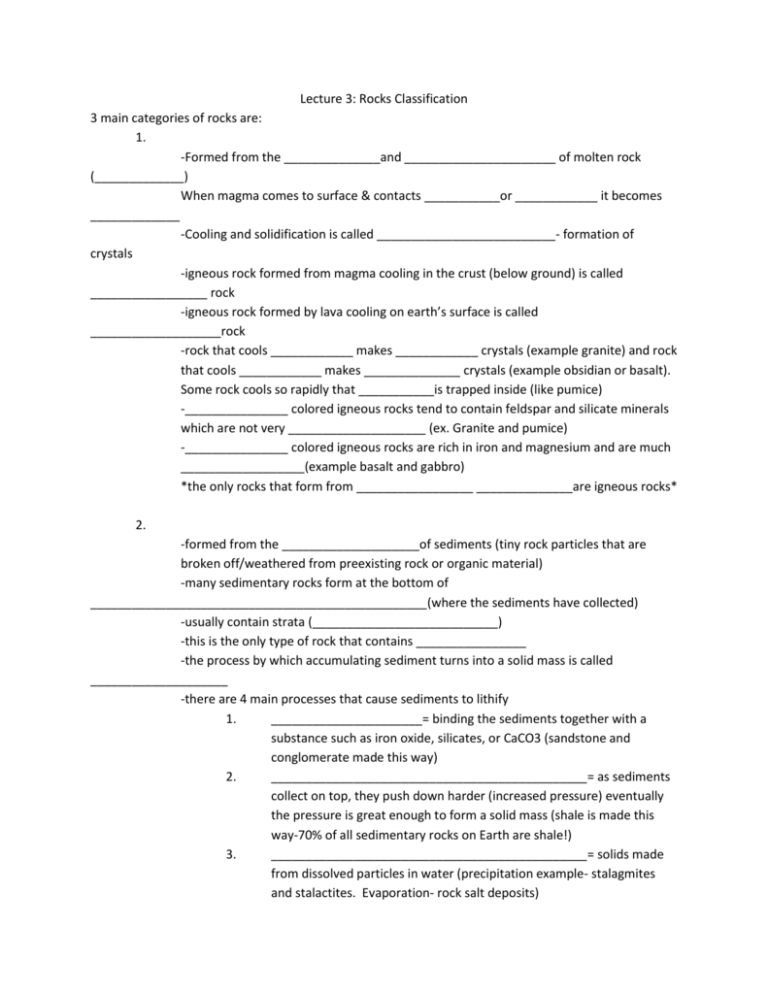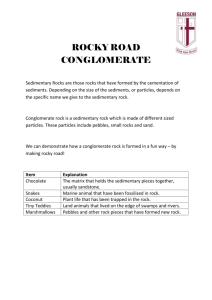File
advertisement

Lecture 3: Rocks Classification 3 main categories of rocks are: 1. -Formed from the ______________and ______________________ of molten rock (_____________) When magma comes to surface & contacts ___________or ____________ it becomes _____________ -Cooling and solidification is called __________________________- formation of crystals -igneous rock formed from magma cooling in the crust (below ground) is called _________________ rock -igneous rock formed by lava cooling on earth’s surface is called ___________________rock -rock that cools ____________ makes ____________ crystals (example granite) and rock that cools ____________ makes ______________ crystals (example obsidian or basalt). Some rock cools so rapidly that ___________is trapped inside (like pumice) -_______________ colored igneous rocks tend to contain feldspar and silicate minerals which are not very ____________________ (ex. Granite and pumice) -_______________ colored igneous rocks are rich in iron and magnesium and are much __________________(example basalt and gabbro) *the only rocks that form from _________________ ______________are igneous rocks* 2. -formed from the ____________________of sediments (tiny rock particles that are broken off/weathered from preexisting rock or organic material) -many sedimentary rocks form at the bottom of _________________________________________________(where the sediments have collected) -usually contain strata (___________________________) -this is the only type of rock that contains ________________ -the process by which accumulating sediment turns into a solid mass is called ____________________ -there are 4 main processes that cause sediments to lithify 1. ______________________= binding the sediments together with a substance such as iron oxide, silicates, or CaCO3 (sandstone and conglomerate made this way) 2. ______________________________________________= as sediments collect on top, they push down harder (increased pressure) eventually the pressure is great enough to form a solid mass (shale is made this way-70% of all sedimentary rocks on Earth are shale!) 3. ______________________________________________= solids made from dissolved particles in water (precipitation example- stalagmites and stalactites. Evaporation- rock salt deposits) 4. Involving some type of ____________________________= collected dead bodies of animals are compressed and compacted (at the bottom of the ocean –fossil limestone. At the bottom of a swamp with dead plants collected- bituminous coal) 3. -formed when ___________________________ rocks undergo a change as a result of exposure to intense ___________and ____________________. -these preexisting rocks are often either _________________ or ______________ rocks (called _____________ rocks) -Metamorphic rocks are often associated with ________________because when mountains form, there is usually lots of heat and pressure -involves recrystallization (new arrangement of the atoms and molecules in a rock and this gives it new_____________) of the minerals inside parent rock -metamorphic rocks become _______________ (having distinct layers) the more intense the heat and pressure the __________________the bands of foliation -metamorphic rocks often have folding or curving and typically higher _________________ than parent rock -metamorphic rocks are often found inside igneous or sedimentary rock *If magma intrudes into an ________________rock layer, the heat can cause metamorphic rock to form as the magma cools it turns into igneous rock, but the existing rock’s contact area has been turned into metamorphic rock. *__________________ is a metamorphic rock whose parent rock was the sedimentary rock limestone -Metamorphic rocks are classified mainly by their______________________________, ___________________, and ________________.







